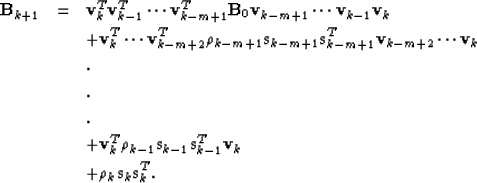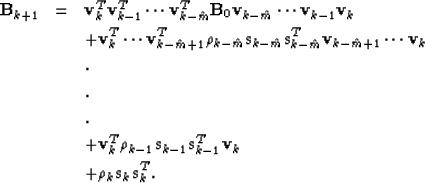




Next: Solving the Huber problem
Up: A quasi-Newton method for
Previous: Proof
For the sake of completeness, I give the updating formulas of the Hessian as presented
by Nocedal (1980). We define first

In addition, we pose  .As described above, when k, the number of iterations, obeys
.As described above, when k, the number of iterations, obeys  , where m is the storage limit, we
have the usual BFGS update
For k+1 > m we have the special limited-memory update
, where m is the storage limit, we
have the usual BFGS update
For k+1 > m we have the special limited-memory update
|  |
|
| |
| |
| (5) |
| |
| |
| |
It is easy to show that the special updated Hessian is also spd. The L-BFGS algorithm is then
Algorithm1
- 1.
- Choose
 , m,
, m,  ,
,  and a symmetric positive definite
and a symmetric positive definite  . Set k=0
. Set k=0
- 2.
- Compute
|  |
(6) |
| (7) |
where  verifies the Wolfe conditions More and Thuente (1994):
verifies the Wolfe conditions More and Thuente (1994):
|  |
(8) |
| (9) |
We always try steplength  first.
first.
- 3.
- Let
 =min
=min ,
, . Check if
. Check if  .
.
- If no:
 (steepest descent step) and delete the pairs
(steepest descent step) and delete the pairs  .
. - If yes: Update

 times using the pairs
times using the pairs  ,
i.e., let
,
i.e., let
|  |
|
| |
| |
| (10) |
| |
| |
| |
- 4.
- Set k:=k+1 and go to 2.
The update  is not formed explicitly; instead, we compute
is not formed explicitly; instead, we compute  with an iterative formula Nocedal (1980).
Liu and Nocedal (1989) propose that we scale the initial symmetric positive definite
with an iterative formula Nocedal (1980).
Liu and Nocedal (1989) propose that we scale the initial symmetric positive definite  at each iteration:
at each iteration:
|  |
(11) |
This scaling greatly improves the performances of the method. Liu and Nocedal (1989) show that
the storage limit for large-scale problems has little effect on the method's performances.
A common choice for m is m=5 (this is the default in my implementation as well).
Conditions (8) and (9) are satisfied if we use an appropriate line search algorithm. I programmed a
MoreThuente line search algorithm More and Thuente (1994), which ensures sufficient decrease of the objective
function (equation 8) and obeys the curvature condition given in equation (9). We do not describe this
program here. In practice, the initial guess  for the Hessian can be the identity matrix
for the Hessian can be the identity matrix  ;
then it might be scaled as proposed above.
Liu and Nocedal (1989) prove that the L-BFGS algorithm converges to the local minimizer
;
then it might be scaled as proposed above.
Liu and Nocedal (1989) prove that the L-BFGS algorithm converges to the local minimizer
 and that the family of solutions
and that the family of solutions  converges R-linearly
converges R-linearly
![[*]](http://sepwww.stanford.edu/latex2html/foot_motif.gif) (remember that the usual BFGS gives q-superlinear convergence, which is better).
(remember that the usual BFGS gives q-superlinear convergence, which is better).





Next: Solving the Huber problem
Up: A quasi-Newton method for
Previous: Proof
Stanford Exploration Project
4/27/2000
![]()


![[*]](http://sepwww.stanford.edu/latex2html/foot_motif.gif) (remember that the usual BFGS gives q-superlinear convergence, which is better).
(remember that the usual BFGS gives q-superlinear convergence, which is better).